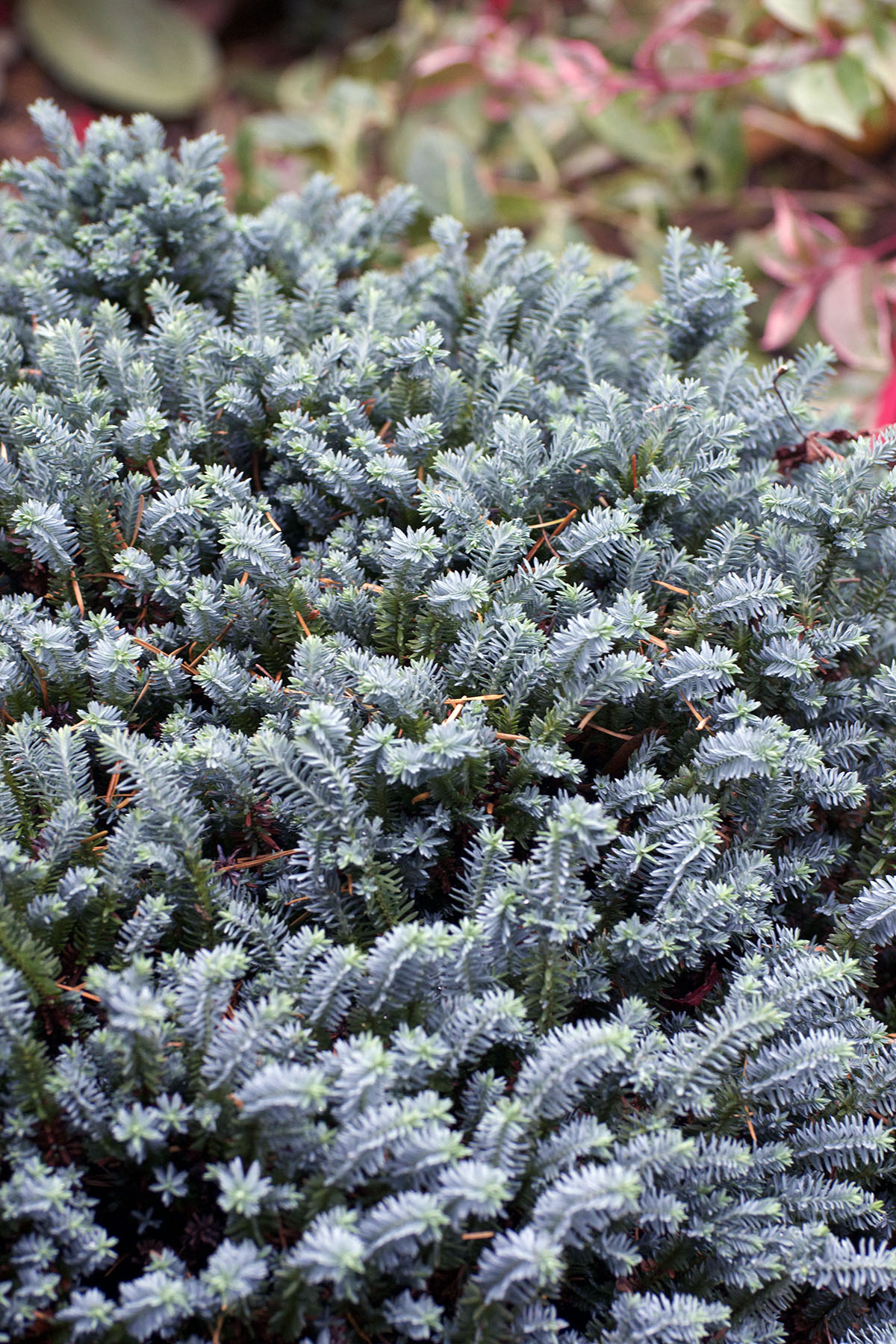Conifers are a group of ancient plants that include cedars, firs, cypresses, junipers, kauri, larches, pines, hemlocks, redwoods, spruces and yews. I notice them most during the fall season, perhaps because the surrounding hues of yellow in the gardens intensify the blue shades of the trees and the mist in the air gives them a silvery sheen. The structure of their branches, the various arrangements and patterns of their needles start to stand out, garnering attention when surrounding competing flowers are gone.


Conifers flourished in the region in and around Berlin, where this photo of my maternal grandmother, my aunt and my mother (in front) was taken in 1929. And here’s your’s truly with my mom, in front of yet another pine forest around 1955.


Berlin has one of the highest percentages of remaining forests within the city limits, almost 20% compared to say Hamburg or Munich which range in the 5% league. The forests are currently under extreme duress because of drought, heat and unmanageable pests like pine bark beetles. The city government is now planting 329.000 (!) trees, mostly elms and oak trees which are displacing the fragile pines.


Pines and in particular junipers are also an essential part of the Lüneburger Heide, a large area of heath, geest, and woodland in the northeastern part of the state of Lower Saxony in northern Germany close to where my paternal grand parents lived. One of the perennial highlights of our visits was a hike with my Opa to the Ahlftener Flatt, a large pond created by constant winds scooping the sandy loam. It was surrounded by various types of conifers, which we had to identify dutifully in order to make it to the water, the real magnet: time to hunt for frogs and grasshoppers! Or skating in the winter. Only in retrospect have I realized, how much I owe to these nature walks, including my love for birds, whose calls and songs my Opa was whistling to perfection, ever the musician even without his stand-up bass.



The heath has been a National Park since 1909, one of, if not the oldest in Germany. The sandy loam makes it ideal for junipers to grow. They dot the landscape, their dark green offsetting the purple of their surround, when the heather is in bloom. Large flocks of sheep are grazing year round to keep the heather plants in check. You can watch it here.


Considered beauty there yet a curse here, in Oregon, Idaho and Nevada. Juniper used to grow only on rocky surfaces and steep slopes, where they were protected from fires, since little fire fuel grew around them. When settlers started to graze their cattle in the 1870s, native grasses, food for fire, disappeared from the plains as well and so the junipers took root everywhere. The problem? They outcompete grasses and shrubs, killing habitat for wildlife that needs those. They also serve as hiding places for mountain lions, allowing them to stalk pronghorn sheep and antelopes more easily. They use a lot of water, which in turn dries out nearby streams and springs – all of which then affects cattle farmers who have not enough grazing and watering resources left.

Most threatened by junipers, though, are the sage-grouse. Not only do junipers wipe out the sage grass on which the grouse depend. The birds also give anything over four feet tall a wide birth, since a taller tree could host predator birds. The places, then, where they met and mated are now feeling unsafe due to stands of large juniper trees and so they abandon the region without finding suitable replacement. The Bureau of Land Management has undertaken juniper control projects spanning tens of thousands of acres in Oregon alone, and millions of acres across the West, trying to eradicate them by pile burning.


“Several federal and state agencies offer grants to help ranchers tackle invasive juniper on private land. And the BLM coordinates juniper eradication on the vast swaths of public land it manages. One recently completed project in southeastern Oregon spanned 70,000 acres, and another, in the Burns area, aims to clear about 50,000 acres. Past monitoring has shown that the growth and productivity of herbaceous plants like grasses do in fact rebound after juniper is removed, and ranchers have reported increased flow in springs and streams.” (I’ve summarized a longer, beautifully photographed essay on this problem, found here.)
Don’t try it yourself, though: the old trees are protected, they might live for more than a thousand years—some known to be dated at 1,600 years. These trees are irreplaceable, and cutting one down on public land is punishable by a fine of $100,000 and up to a year behind bars.

It is such a complex issue in interdependent eco systems where the arrival of non-native species, or human interference with the natural-set up of a region can bring looming catastrophe.
Let’s revel in the beauty of the various conifer species I photographed last week, though, thoughtfully planted in a garden where they do no harm to larger expanses of wilderness.


Music has to be The Juniper Tree from the bitter Grimm Fairy Tale.






Sara Lee Silberman
Wonderful photos – especially of you/yours – and what an interesting, complex, and alarming ecological story you have (so well) told….
Louise A Palermo
This was such a wonderful article! Thank you for sharing your amazing family pictures as well as the conifer family we should all appreciate more!
Ken Hochfeld
I LOVE these precious photos!!!